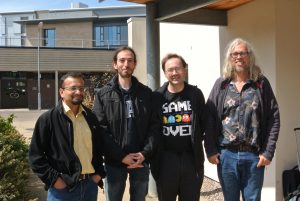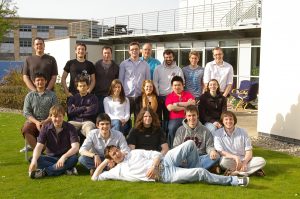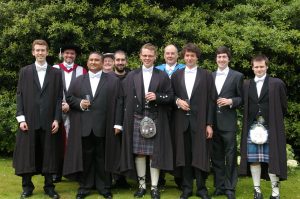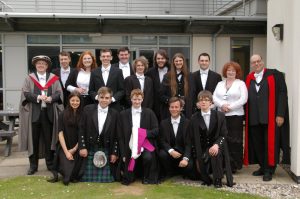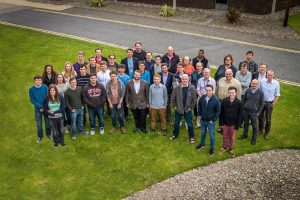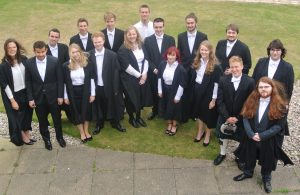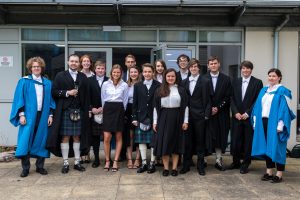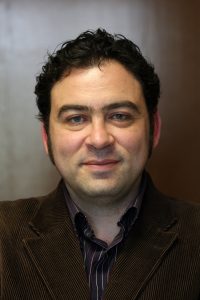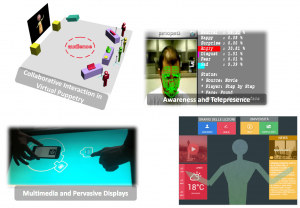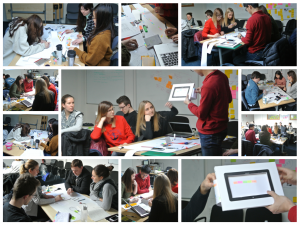Congratulations to Franck Slama, who successfully defended his thesis yesterday. He is pictured with supervisor Dr Edwin Brady, Internal examiner Dr Susmit Sarkar and external examiner Professor Thorsten Altenkirch, from the University of Nottingham
IDIR Summer Workshop 2018
The St Andrews Institute for Data-Intensive Research (IDIR) was set up in September 2014 to provide a focus for research and teaching activities across the University driven by access to “big data”.
IDIR does not directly sponsor or manage any research of its own: rather, we help researchers to collaborate within and beyond their home Schools in areas relating to data and computationally-intensive research.
In the past we have hosted the Summer of Vs (Variety, Veracity, Velocity & Volume) and Summer of Data Workshop Series.
This year we are hosting a series of IDIR Summer Workshops tailored by the interests of the researchers in IDIR. The themes that were identified (and the dates on which each workshop is held) are
03.07.2018 Text and/or Image Processing
24.07.2018 Data (Science) Best Practices
16.08.2018 Health and Simulation Data
04.09.2018 Cloud Computing, High Performance Computing, Reproducibility
This year’s programme of events are being organised by Özgür Akgün and Ruth Hoffmann. Get in touch with them if you would like to contribute.
Ubiquitous User Interfaces by Aaron Quigley in the University of Lleida, Spain
In the context of “User Centred Design” course, Professor Quigley delivered a series of lectures on Ubiquitous User Interfaces in the University of Lleida, Spain. These lectures draw on a number of SACHI research group studies from work published in UIST, CHI, MobileHCI, IUI, AVI and UMAP.
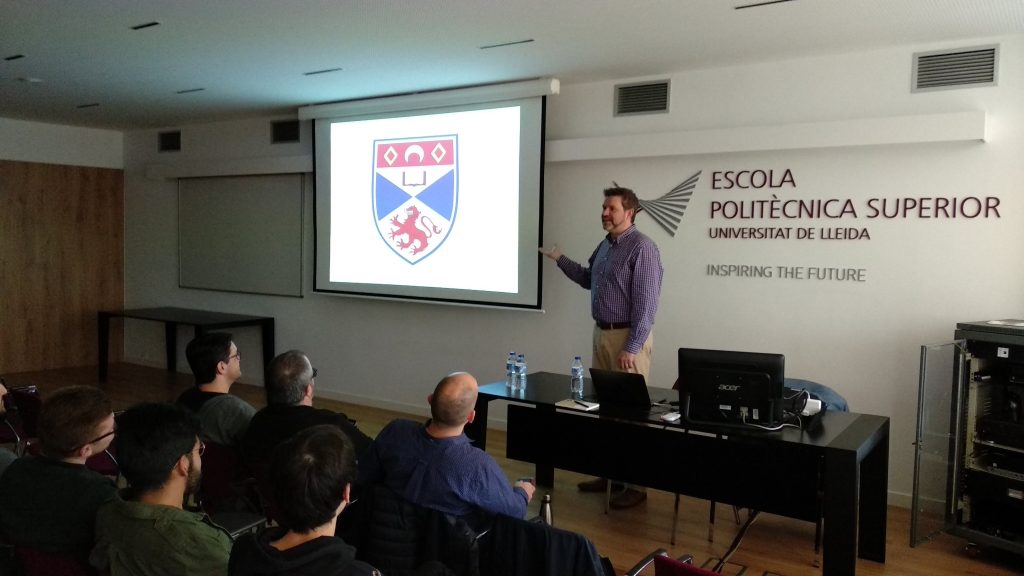
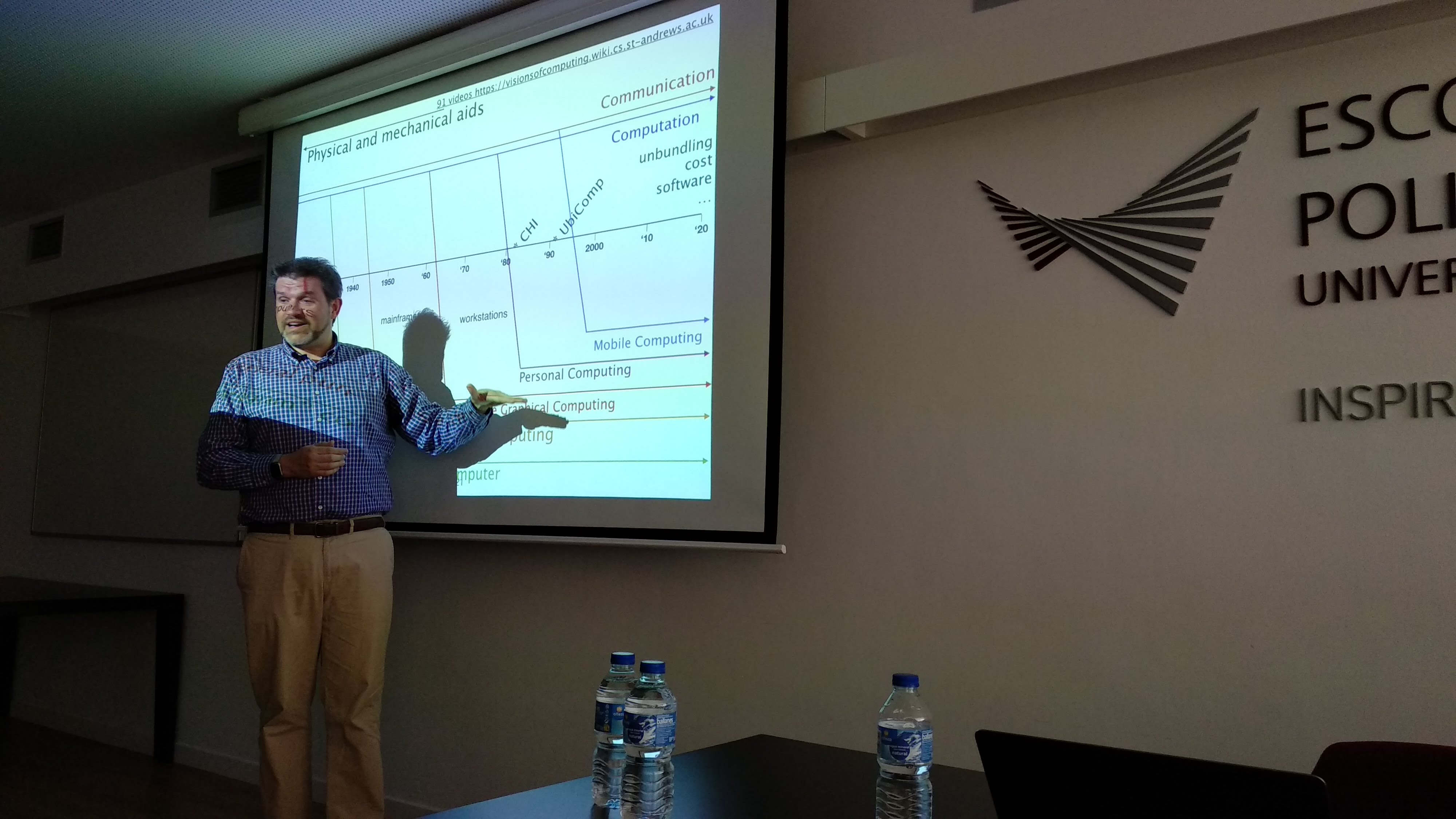
SICSA Education Workshop
A SICSA Education workshop on Learning Analytics for Improving Evidence-based Teaching will be organised in St Andrews during summer 2018 by Dr Kasim Terzic.
Graduation Reception: Wednesday 27th June 2018
The School of Computer Science, will be hosting a graduation reception on Wednesday 27th June, in the Jack Cole building, between 10.30 and 12.30. Graduating students and guests are invited to the School to celebrate with a glass of fizz. Computer Science degrees will be conferred in an afternoon ceremony in the Younger Hall. A class photo will be taken at 11am in the Jack Cole building. Family and friends who can’t make it on the day can watch a live broadcast of graduation.
Graduation receptions have been held in the school from 2010 and some class photos have been captured for posterity.
Why Homotopy type Theory (HoTT) matters – Professor Thorsten Altenkirch
Abstract:
Dependent types are a wonderful way to construct correct functional programming and specify interfaces as Edwin has shown in his nice book on type driven development using a welsh dragon. But shall we go further in the esoteric world of homotopy type theory? I will try to motivate this and I am looking forward to some discussions with people who have a more pragmatic attitude to dependent types.
Event details
- When: 25th May 2018 11:00 - 12:30
- Where: Cole 1.33a
- Format: Seminar
The OpenMP and MPI refactoring with ParaFormance – Turkey Alsalkini
Abstract:
The increasing complexity of codes with the growing number of cores that should be utilised make such codes hard to optimise and maintain. In this talk, we present the OpenMP and MPI refactoring implemented in the ParaFormance tool. This tool transforms the sequential code into parallel code able to run on shared memory machines. Further refactoring is implemented to adapt the source code to exploit a larger number of processors on large HPC clusters with message passing support. In addition, the resulting MPI code can be used by developers as a starting point for further optimisation. Both refactorings are preceded by an advanced safety checking which reports concurrency problems and gives hints and suggestions on how to fix them.
Event details
- When: 17th May 2018 12:00 - 13:00
- Where: Cole 1.33a
- Format: Talk
SACHI Seminar: Alessio Malizia – User Experience: a step towards Natural User Interfaces.
Title: User Experience: a step towards Natural User Interfaces.
Abstract: The road to natural interfaces is still long and we are now witnessing an artificial naturality. These interfaces are natural, in the sense they employ hand gestures, but they are also artificial, because the system designer imposes the set of gestures. In this lecture we will explore together the benefits and issues of Natural User Interfaces.
Speaker biography: Alessio Malizia is a Professor of UX Design at the University of Hertfordshire and a distinguished speaker of the ACM (the international Association for Computer Machinery); he lives in London but is a “global soul” and has been living in Italy, Spain and US. He is the son of a blacksmith, but thereafter all pretensions of manual skills end. Prof. Malizia began his career as a bearded computer scientist at Sapienza – University of Rome and then, after an industrial experience in IBM and Silicon Graphics, moved on with a career in research. He was visiting researcher at the Xerox PARC where he was appreciated for his skills in neural networks (Multilayer Perceptrons) and as peanut butter and chocolate biscuits eater. He worked as Senior Lecturer at Brunel University London and as Associate Professor (and Spanish tapas aficionado) at the University Carlos III of Madrid. Prof Malizia’s research and teaching interests focus on Human-Centred Systems.
He is interested in the design of Ubiquitous Interactive Systems with a special focus on the End-User Development community. He is particularly interested in systems where the physical and digital become seamlessly intertwined producing a new hybrid landscape and the study of problems arising from designing such complex hybrid environments involving collaboration of various disciplines and stakeholders. In his role at the School of Creative Arts at University of Hertfordshire, he is keen to develop novel approaches and attract funding for improving methods to design almost invisible interfaces embedded in a physical environment naturally exploited by users’ innate interaction modalities.
Event details
- When: 7th June 2018 14:00 - 15:00
- Where: Cole 1.33a
- Format: Seminar
Professor Aaron Quigley to Join ACM Distinguished Speaker Program
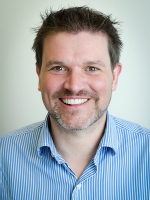
Congratulations to Aaron on being appointed as a Distinguished Speaker for the Association for Computing Machinery (ACM). The esteemed Distinguished Speaker Program brings together international thought leaders from academia, industry, and government to give presentations to ACM chapters, members, and the greater IT community in a variety of venues and formats. The outreach program coordinates speaker lectures to consider the most important challenges in computing today and facilitates professional networking.
Aaron has developed four lectures for the DSP program here can deliver, these include:
Discreet Computing
Computing and interaction are changing the nature of humanity. As individuals our capabilities can be extended, our memories augmented and our senses attuned. Societies are being reshaped…
Global Human Computer Interaction
Global Human Computer Interaction is the study of HCI when considering global challenges, languages, concerns, cultures and different economic drivers. Digital technologies now underpin the…
Immersive Analytics
Human activity (in all its forms) can result in large volumes of data being collected and simply stored in the hope that one day it can be analysed and explored. From business to health…
Ubiquitous User Interfaces (UUI)
UbiComp or Ubiquitous Computing is a model of computing in which computation is everywhere and computer functions are integrated into everything. It can be built into the basic objects,…
Professor Quigley is Chair of Human Computer Interaction in the School of Computer Science at the University of St Andrews. His research interests include surface and multi-display computing, body worn interaction, human computer interaction, pervasive and ubiquitous computing and information visualisation.
User-Centred Interaction Design
Students undertaking CS5042 User Centred Interaction Design were pictured prototyping their design ideas during creative thinking, and hands-on sessions earlier this month. UCID provides experience with modern design methodologies, introduces the philosophy of interaction design and involves working with actual clients.
The module delivered by Miguel Nacenta is a compulsory element for students studying on our MSc in Human Computer Interaction, a popular addition to our MSc Portfolio.
Images courtesy of Miguel Nacenta


